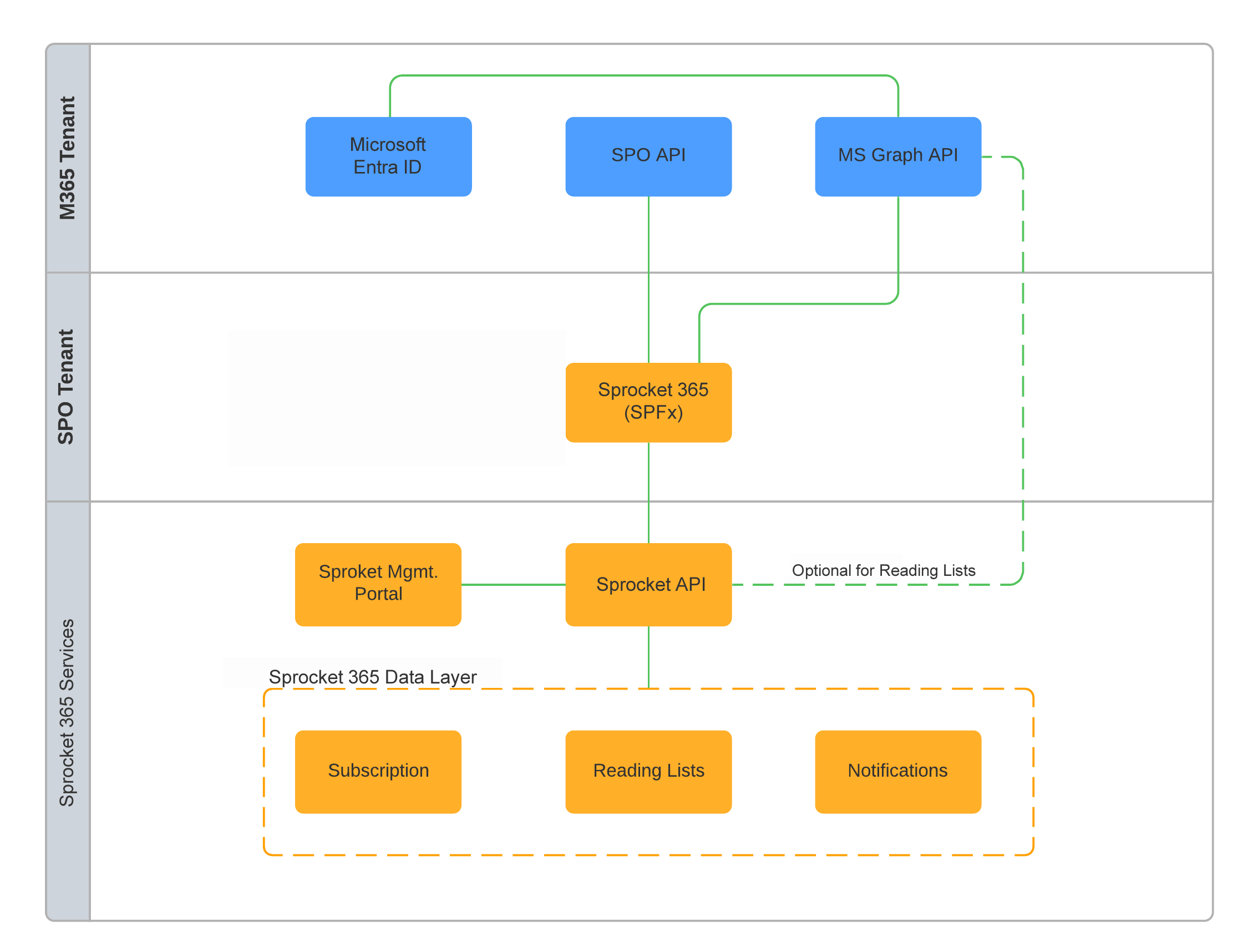Overview
Sprocket consists of a client layer, which is implemented by two Microsoft SharePoint Framework Apps. The client layer reads data from various external systems, such as Microsoft Graph or SharePoint Search and displays this data in web parts within a SharePoint site.
Sprocket provides a number of web parts and customizers for SharePoint Modern. This article details the technical architecture of Sprocket and the services in which is depends on.

Platform
Sprocket is built with Microsoft SharePoint Framework (SPFx), which is the recommended way and technology issued by Microsoft for implementing custom solutions for the Microsoft 365 platform.
Installation
The solution consists of an SPFx app package "Sprocket 365", which has to be deployed into the customer's SharePoint Online App Catalog. Once deployed to the App Catalog, the app package can be installed as Apps on the desired SharePoint sites. Refer to our installation page for more information.
Required Permissions
When deploying Sprocket, a set of permission requests are created that need to approved in the "API Management" section in the SharePoint Admin Center.
Be aware the you might not need all permissions, if you don't need the functionality that requires them. Also note, that everything is executed under the context of the logged in user. That means users will only be able to load data, they are have permission to.
The below list are the Microsoft Graph permissions that are needed for all of Sprocket's web parts to function correctly. For more information on Microsoft Graph and what these permissions request mean please refer to Microsoft Graph permissions reference article.
Microsoft Graph API
- Delegated: User.Read.All
- Delegated: People.Read.All
- Delegated: Directory.Read.All
- Delegated: Group.Read.All
- Delegated: Files.Read.All
- Delegated: Presense.Read.All
- Delegated: Sites.ReadWrite.All
- Delegated: Contacts.Read.All
Data storage
All business information is stored within your Microsoft 365 tenant e.g. documents, configuration, pages etc.
When Sprocket functionality is loaded within SharePoint it will call our Sprocket API service to ensure your tenant has a valid Sprocket subscription and enough seats. For us to determine this information we store your tenant ID, user IDs (no personal) & tenant admin information. See managing your subscription for more information.
Optional Modules
Knowledge Hub
Sprocket includes our "Knowledge Hub" feature which leverages SharePoint Modern and adds additional capabilities for providing a better user experience for your workforce to access policies, procedures, and knowledge base articles. All page content and navigation is stored within your Microsoft 365.
Knowledge Hub provides significant enhancements (included within your subscription) that you may wish to utilise. These additional features require additional permissions to be granted.
Knowledge Hub can be split into three key features; Content, Read Lists, & Converters.
Data Storage
The Content features of Knowledge Hub is essentially the enhanced user experience within SharePoint – providing a hierarchy navigation, search & other commands like print, table of contents, read duration etc. All of this content and functionality uses SPFx and fits within the standard Sprocket scope as per detailed in the 'platform' section above. No additional security is required for this to function. There is no dependency on Sprocket services and no data is stored outside of your Microsoft 365 tenant.
Converters
A popular feature for Sprocket subscribers to use our Sprocket Converters to help with content management. The converters allow admins to convert existing Word documents into SharePoint pages & PDF documents directly from within SharePoint.
Subscribers will use a SharePoint document library to store policies & procedures making use of its co-authoring, version control, meta data etc.
When a document is converted it can be used to convert the Word document into a SharePoint page for the consumption of the workforce. At the same time the Word document can be converted to PDF and the PDF stored in a defined SharePoint document library and link created between the page and the PDF.
Read Lists
Sprocket's Reding List feature enables Admin's and management staff to ensure the workforce has acknowledged & read the required pages of the Knowledge Hub's. For those pages that have been marked as required to be read – users will need to navigate to each of the pages and click the 'mark as read' button. Admins & managers can produce reports on who has read what pages on what dates.
Permissions
For a tenant to utilise the Read List feature of Knowledge Hub a tenant admin must approve the Sprocket Knowledge Hub Application. The approval grants Sprocket's API to connect to your tenants Microsoft Graph with the following permissions:
- Application: User.Read.All
- Application: Sites.Read.All
- Application: GroupMember.Read.All
For more information on Microsoft Graph and what these permissions request mean please refer to Microsoft Graph permissions reference article.
If you would prefer not to approve the requested sites.read.all permission and restrict access to only certain sites, please contact us so we can provide you with steps on how to use the sites.selected scope.
FAQs
How does Sprocket 365 handle updates that Microsoft make in the underlying SharePoint platform?
Sprocket 365 is built using the SharePoint Framework (SPFx), following best practices to extend the Microsoft 365 platform. As Microsoft continues to evolve and update SharePoint, it ensures backward compatibility with SPFx-based solutions, safeguarding the stability of custom features built on this framework.
Sprocket 365 closely monitors all updates to the SharePoint platform by leveraging Microsoft's First Release and Standard Release cycles. Our development environments operate on the First Release cycle, enabling us to identify and address any potential issues before updates are rolled out to production environments, where most of our customers run on the Standard Release cycle.
In the unlikely event that a Microsoft update affects a custom feature within Sprocket 365, our development team will have a patch or update ready in advance, ensuring minimal disruption. This proactive approach allows us to maintain compatibility with SharePoint updates and ensure the ongoing functionality of all custom features.